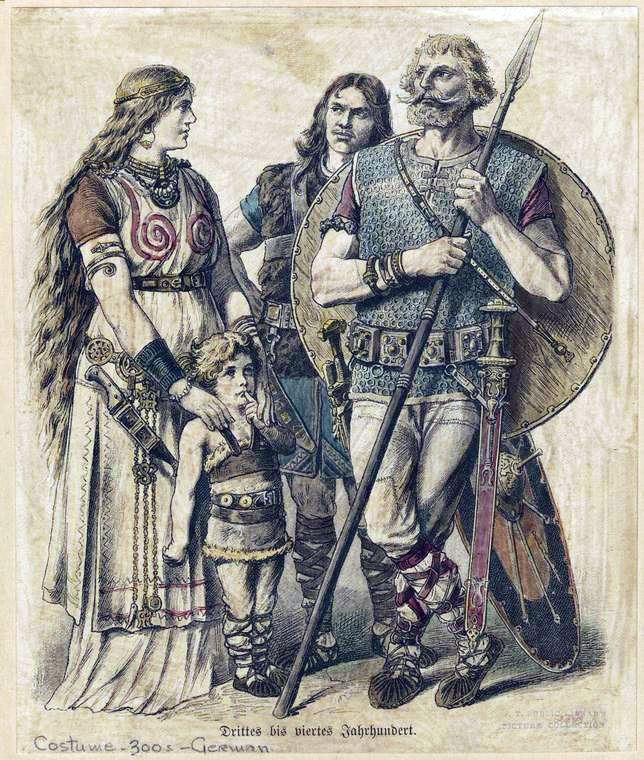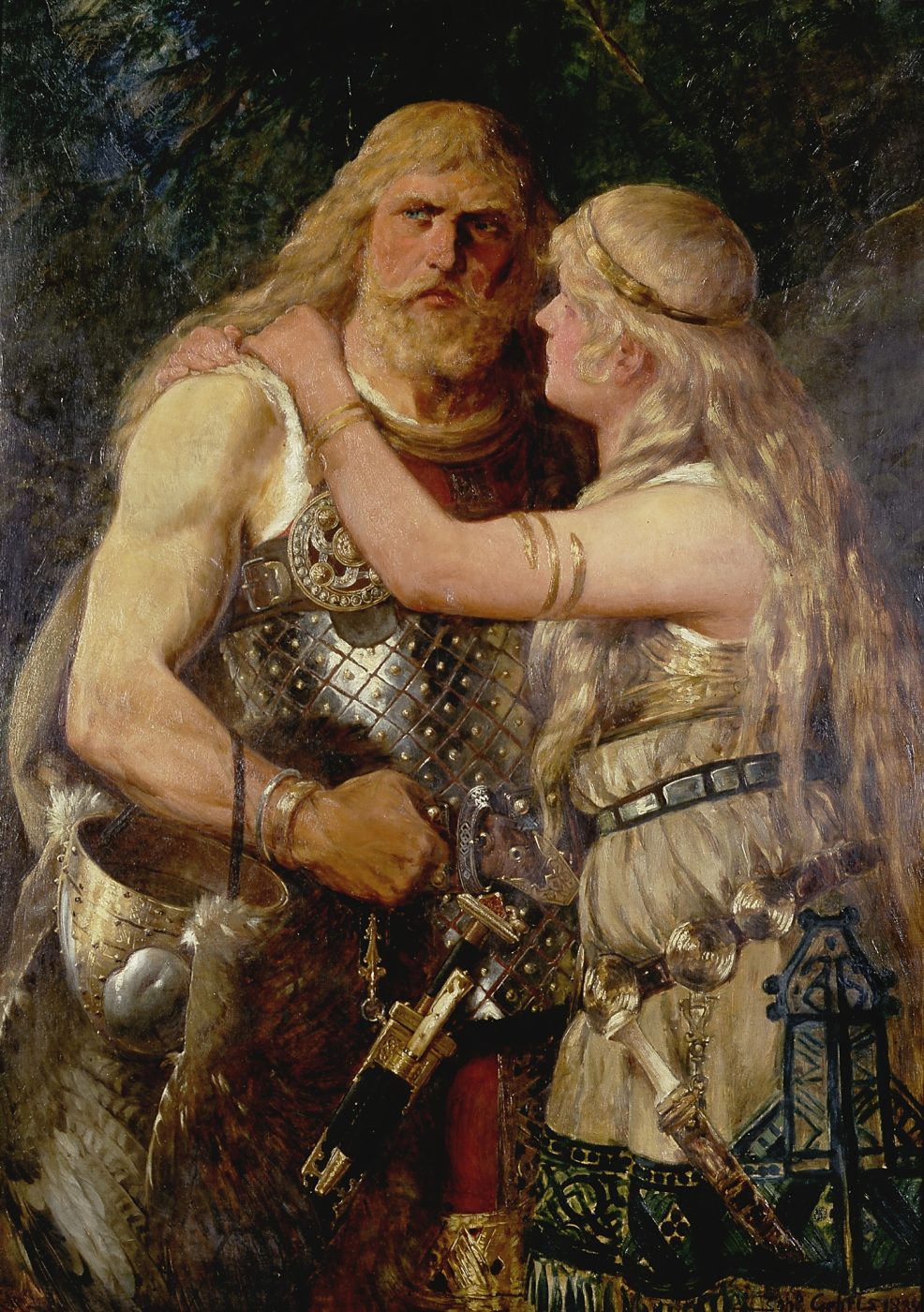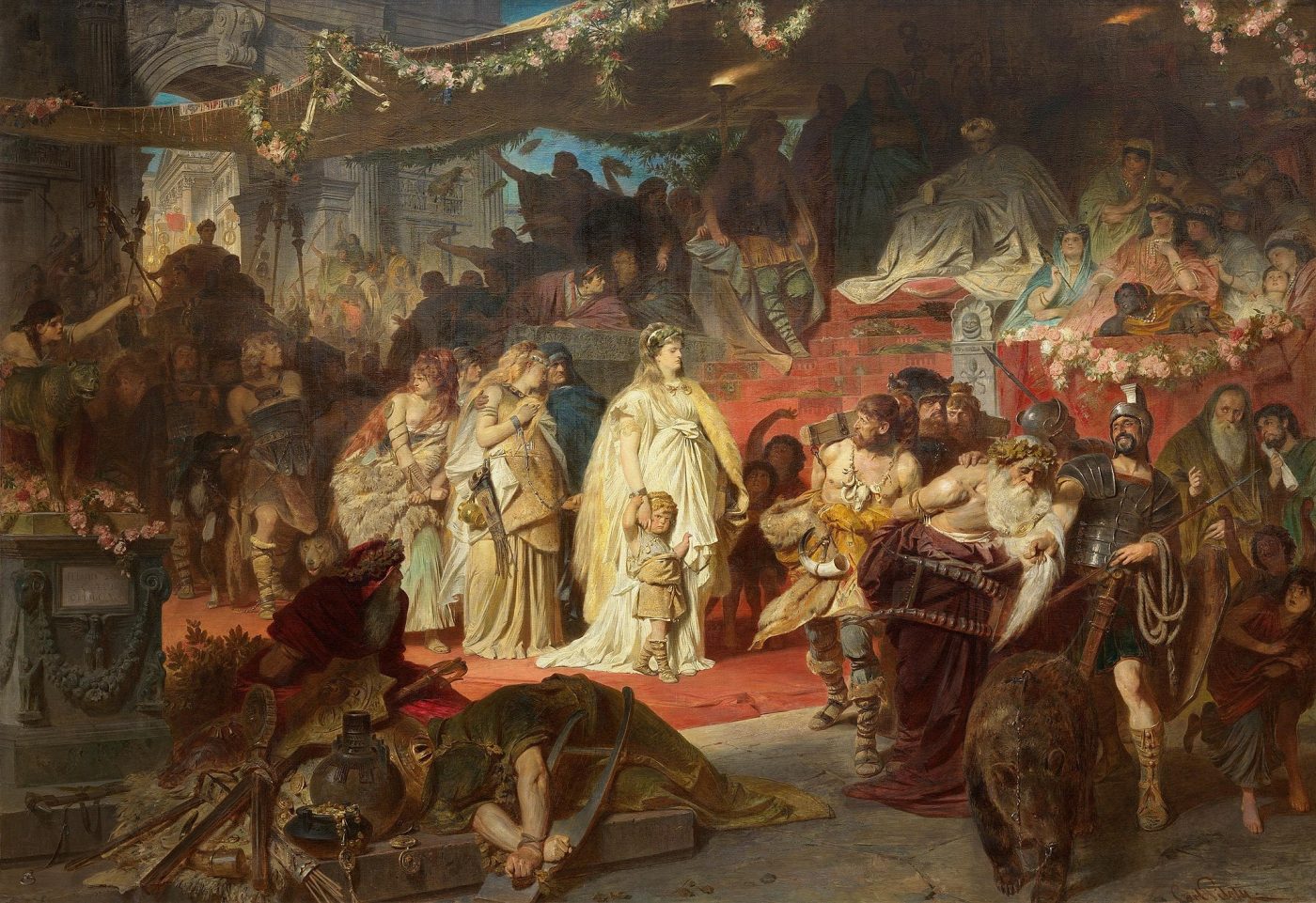In the vast tapestry of history, few empires have left as indelible a mark as the Roman Empire. With its sprawling territories, intricate bureaucracy, and advanced engineering, Rome was a beacon of civilization in a world fraught with challenges. Among these challenges were the Germanic tribes, a collection of diverse groups that often found themselves in conflict with the Roman Empire. From the Roman perspective, these tribes were seen as barbaric threats that needed to be managed, if not subdued. This article delves into the Roman treatment of the Germanic tribes, offering a glimpse into the complexities of ancient geopolitics.
The Germanic Tribes: A Brief Overview
The term “Germanic tribes” is an umbrella term that encompasses a myriad of groups, each with its own distinct culture, traditions, and territorial claims. From the Suebi to the Goths, these tribes roamed the lands beyond the Roman frontiers, particularly in the regions that are now modern-day Germany, Denmark, and Sweden. Their semi-nomadic lifestyles, warrior ethos, and decentralized political structures starkly contrasted with the Roman way of life.
Rome’s Initial Encounters
Rome’s first encounters with the Germanic tribes were not of conquest but of trade and diplomacy. The empire’s vast network of roads and trade routes extended to the edges of Germanic territories. However, as Rome expanded its borders, clashes became inevitable. The Romans viewed these tribes as “barbarians” – a term derived from the Greek word “barbaros,” meaning foreign or strange. This label was less a reflection of the tribes’ actual behavior and more an indication of their unfamiliarity to the Roman way of life.
The Challenges of Integration
The Roman strategy, when dealing with conquered territories, was often one of assimilation. They would introduce Roman law, language, and culture, aiming to transform these regions into miniatures of Rome itself. However, the Germanic tribes presented a unique challenge. Their fierce independence and warrior culture resisted easy assimilation. Moreover, the dense forests and harsh climates of their homelands were a far cry from the Mediterranean landscapes the Romans were accustomed to.

Commons
Battles and Alliances
The relationship between Rome and the Germanic tribes was not solely adversarial. There were moments of cooperation and alliance. For instance, many Germanic warriors found themselves serving in the Roman legions, drawn by the promise of steady pay and the allure of Roman citizenship. On the other hand, there were significant clashes, such as the Battle of the Teutoburg Forest in 9 AD, where three Roman legions were ambushed and annihilated by a coalition of Germanic tribes. This battle, among others, underscored the need for Rome to approach the Germanic tribes with a mix of respect and caution.
The Later Years: From Threat to Settlement
As the Roman Empire evolved, so did its relationship with the Germanic tribes. By the late empire, many Germanic groups had settled within Roman territories, often serving as foederati, or allied troops. These arrangements were mutually beneficial: the tribes received land and protection, while Rome gained a buffer against other external threats.
However, the increasing integration of Germanic tribes into the Roman fabric came with its own set of challenges. Cultural exchanges led to the blending of Roman and Germanic traditions, but also to tensions and occasional conflicts. The eventual sacking of Rome by the Visigoths in 410 AD is a testament to the complex and ever-shifting dynamics between the empire and the Germanic tribes.
Conclusion: A Relationship Defined by Complexity
From the Roman perspective, the Germanic tribes were both a threat and an opportunity. They were formidable adversaries on the battlefield, yet also potential allies and contributors to the Roman state. The story of Rome’s interactions with the Germanic tribes is not one of simple conquest or suppression, but of negotiation, adaptation, and mutual influence.
As modern readers, it’s essential to approach this chapter of history with an open mind, recognizing that the narrative is multifaceted. The Roman treatment of the Germanic tribes offers valuable insights into the challenges and rewards of intercultural interactions, lessons that remain relevant in today’s globalized world.
The Roman Treatment of Germanic Tribes: A Germanic Perspective
In the annals of history, the Roman Empire often takes center stage with its grandeur, conquests, and innovations. But beyond the Roman frontiers, a tapestry of diverse tribes and cultures thrived, each with its own story. Among them were the Germanic tribes, a collective of proud and independent people who, for centuries, resisted Roman encroachment. This article aims to shed light on the Germanic perspective, offering a fresh lens through which to view the age-old tussle between the Romans and the Germanic tribes.

Understanding the Germanic Tribes
Before delving into the heart of the matter, it’s crucial to understand who the Germanic tribes were. Contrary to the monolithic image often portrayed, the Germanic tribes were a mosaic of different groups, each with its distinct identity. From the fierce Goths to the maritime Saxons, these tribes inhabited the vast lands stretching from modern-day Scandinavia to central Europe.
The Roman Shadow Looms
As the Roman Empire expanded its territories, its shadow began to loom over the Germanic homelands. For the tribes, the Romans were not just another neighboring entity; they represented a colossal force that had subdued countless cultures in its path. The Germanic tribes, with their warrior ethos and deep-seated love for freedom, were not about to be mere footnotes in Rome’s expansive history.
The Struggle for Autonomy
The Germanic tribes’ resistance to Roman encroachment was not merely a military endeavor. It was a struggle for autonomy, a fight to preserve their way of life, traditions, and beliefs from Roman assimilation. While the Romans viewed their expansion as a civilizing mission, bringing the light of Roman culture to the ‘barbarians,’ the Germanic tribes saw it as an invasion of their ancestral lands and an affront to their sovereignty.
Battles, Treaties, and Diplomacy
The resistance against Roman encroachment was multifaceted. On one hand, there were fierce battles, like the legendary Battle of the Teutoburg Forest, where the Germanic tribes, under the leadership of Arminius, ambushed and decimated three Roman legions. This victory was not just a military triumph but a powerful statement of Germanic resilience.
However, resistance wasn’t just about warfare. The Germanic tribes were adept at diplomacy and often entered treaties with the Romans, sometimes out of necessity and sometimes as strategic moves. These treaties, while offering temporary respite, were also fraught with challenges. The Romans, with their intricate bureaucracy, often had the upper hand in negotiations, leading to treaties that were skewed in their favor.
Cultural Resilience
Beyond the battlefield and diplomatic tables, the Germanic tribes resisted Roman encroachment through cultural resilience. They held onto their pagan beliefs, languages, and traditions, ensuring that their identity remained distinct. Even in regions where the Romans established strongholds, the Germanic way of life persisted, often blending with Roman elements to create a unique cultural amalgamation.
The Tides of Time
As centuries rolled on, the dynamics between the Romans and the Germanic tribes evolved. While early interactions were marked by stark resistance, later years saw increased integration. Many Germanic tribes began to settle within the Roman territories, not as subjugated people but as allies or foederati. This shift, however, came with its own set of challenges, as the tribes grappled with maintaining their identity in the face of Roman influence.
Conclusion: A Tale of Resilience and Identity
The story of the Germanic tribes and their resistance to Roman encroachment is a testament to the indomitable spirit of a people determined to safeguard their identity. It’s a narrative that underscores the complexities of ancient geopolitics, where battles were fought not just with swords but with beliefs, traditions, and diplomacy.
The Battle of the Teutoburg Forest
In the annals of ancient history, few events have had as profound an impact on the Roman Empire’s trajectory as the Battle of the Teutoburg Forest. Taking place in 9 AD, this battle saw a coalition of Germanic tribes deliver a crushing defeat to three Roman legions, forever altering Rome’s ambitions in Germanic territories.

The Prelude
The Roman Empire, under the leadership of Emperor Augustus, was in an expansionist phase. The vast territories of Germania (modern-day Germany) lay to the north of the empire’s borders and were seen as the next frontier for Roman expansion. However, Germania was not a monolithic entity; it was a mosaic of various Germanic tribes, each with its distinct identity and territory.
The Betrayal
Central to the events leading up to the battle was a young Germanic noble named Arminius. Having been raised in Rome as a hostage, Arminius was familiar with Roman military tactics and strategies. He had even earned Roman citizenship and was serving as an auxiliary officer. However, his loyalty lay with his Germanic roots.
Secretly rallying various Germanic tribes, Arminius masterminded a plan to ambush the Roman legions. The Romans, led by Publius Quinctilius Varus, were lured into the dense Teutoburg Forest under the pretense of quelling a local uprising.
The Ambush
The dense forest and torrential rains created the perfect setting for an ambush. The Roman legions, used to open battlefields, found themselves trapped and unable to maneuver. Over three days, the Germanic tribes, using guerrilla warfare tactics, decimated the Roman forces. It’s estimated that up to 20,000 Roman soldiers were killed.
The Aftermath
The impact of the battle was immediate and profound. Augustus, upon hearing the news, was reported to have banged his head against the walls, lamenting, “Varus, give me back my legions!” The defeat was so severe that Rome never again attempted to conquer the Germanic territories east of the Rhine River.
Thusnelda: A Tale of Love, Betrayal, and Roman Ambitions
In the vast expanse of the Roman Empire’s history, individual tales often get overshadowed by grand battles and imperial conquests. Yet, the story of Thusnelda, a Germanic princess, offers a poignant glimpse into the personal costs of the larger geopolitical struggles between Rome and the Germanic tribes.
A Princess of the Cherusci
Thusnelda was a noblewoman of the Cherusci tribe, one of the prominent Germanic tribes that resisted Roman encroachment. She was the daughter of Segestes, a chieftain who, despite his tribal affiliations, often favored cooperation with the Romans.

A Forbidden Love
In a twist that could rival modern love dramas, Thusnelda fell in love with Arminius, a Cheruscan prince and the mastermind behind the Roman defeat at the Battle of the Teutoburg Forest. Their union was not just a personal alliance but also a symbol of Germanic unity against Roman ambitions. However, this marriage was against Segestes’ wishes, leading to a deep familial rift.
Capture and Display
The tensions between father and daughter reached a climax when Segestes, leveraging his ties with the Romans, had his daughter captured in 15 AD. Thusnelda was then presented to the Roman general Germanicus, who paraded her as a prized capture, a symbol of Rome’s dominance over the ‘barbaric’ Germanic tribes.
The humiliation didn’t end there. In 26 AD, she was displayed in a grand procession in Rome, a spectacle meant to celebrate the might of the Roman Empire. The fate of Thusnelda post this event remains shrouded in mystery, but her story stands as a testament to the personal tragedies that often get overshadowed by grand historical narratives.

1. How did trade and commerce influence Roman-Germanic relations?
While military confrontations often dominate the narrative, trade played a pivotal role in shaping Roman-Germanic relations. The Rhine and Danube rivers served as vital trade routes, facilitating the exchange of goods like amber, fur, and slaves from Germanic territories for Roman wine, pottery, and luxury items. This commerce fostered interdependence, leading to periods of peace and cooperation, even amidst larger geopolitical tensions.
2. Were there any Germanic tribes that willingly aligned with the Roman Empire?
Yes, several Germanic tribes chose to align with the Romans, either for protection against more powerful Germanic rivals or to reap the benefits of Roman civilization. The Batavi, for instance, settled in the Roman Empire and became renowned for their service in the Roman legions. Such alliances were often pragmatic, highlighting the nuanced nature of Roman-Germanic interactions.
3. How did the Roman-Germanic interactions influence the Roman military?
The Romans were quick learners and often adapted their military tactics based on their adversaries. Encounters with the Germanic tribes, known for their fierce infantry and guerrilla warfare, led the Romans to make tactical adjustments. Additionally, many Germanic warriors, admired for their combat skills, were integrated into the Roman legions, further influencing Roman military strategies.
4. How did religion play a role in the Roman treatment of Germanic tribes?
Religion was a cornerstone of both Roman and Germanic societies. While the Romans practiced a polytheistic religion with an emphasis on state gods, the Germanic tribes had their own pantheon of deities. As the Romans tried to integrate the Germanic tribes, there were efforts to merge religious practices, leading to syncretism. However, the Germanic tribes often resisted Roman religious impositions, further emphasizing their distinct identity.
5. What impact did the fall of the Western Roman Empire have on the Germanic tribes?
The decline of the Western Roman Empire in the 5th century AD provided an opportunity for several Germanic tribes to carve out kingdoms within former Roman territories. Tribes like the Visigoths, Vandals, and Ostrogoths established powerful kingdoms in Spain, North Africa, and Italy, respectively. This period marked the transition from mere tribal entities to significant political powers in post-Roman Europe.



